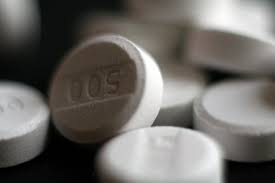March 12th, 2011 by Emergiblog in Book Reviews, Opinion
3 Comments »

 Chocolate and vicodin? No, it’s not the latest Ben & Jerry’s flavor. “Chocolate & Vicodin: My Quest For Relief From the Headache That Wouldn’t Go Away” is the latest book by author, blogger, web designer, and busy woman Jennette Fulda.
Chocolate and vicodin? No, it’s not the latest Ben & Jerry’s flavor. “Chocolate & Vicodin: My Quest For Relief From the Headache That Wouldn’t Go Away” is the latest book by author, blogger, web designer, and busy woman Jennette Fulda.
I became acquainted with Jennette’s blog during BlogHer 2008, where I had purchased her first book, “Half-Assed: A Weight-Loss Memoir.” When she asked if I would like a copy of “Chocolate & Vicodin” to review, I jumped at the chance.
In “Half-Assed,” Jennette chronicled her journey to a near-200 pound weight loss. Just prior to that book’s release, she began another journey — one whose goal proved elusive. On February 17, 2008, Jennette went to bed with a headache. She still has the headache.
Name a diagnosis, she’s heard of it (brain tumor, dead twin in the brain, etc.) Name a treatment, she’s tried it (meds, massage, marijuana, mint chocolate chip ice cream, etc.) In “Chocolate & Vicodin,” Jennette is on a journey to find relief from chronic headache. Writing in a comfortable style, Jennette has a subtle humor that will have you laughing out loud. Trust me, her description of using marijuana “for medicinal purposes only” will have your beverage of choice coming out your nose! (Cover the book!)
But it will also choke you up. Under the humor, under the crazy e-mails from readers that suggest the crazy remedies, this is a serious story of chronic pain disrupting life. Persistent, excruciating pain and the work of coping with it takes a toll on Jennette, and when it becomes too much you find yourself sobbing with her. Read more »
*This blog post was originally published at Emergiblog*
January 14th, 2011 by admin in Health Tips, News, Video
No Comments »
 This is a guest post from Dr. Mary Lynn McPherson.
This is a guest post from Dr. Mary Lynn McPherson.
**********
FDA Restricts Acetaminophen In Popular Pain Medications
The Food and Drug Administration (FDA) made an announcement yesterday that affects one of the most common pain medications on the market, and as a consequence may affect countless numbers of the 75 million Americans who experience chronic pain (for perspective, that’s more than the number of people suffering from cancer, heart disease and diabetes combined.) The FDA has asked manufacturers of popular prescription pain medications like Vicodin or Percocet to limit the amount of acetaminophen (also known as Tylenol, or APAP) used in these drugs to no more than 325 milligrams per tablet — the equivalent of one regular-strength Tylenol tablet.
The move came because research has shown that acetaminophen can cause liver damage when taken in higher than recommended doses. The problem is that many over-the-counter medications ALSO contain acetaminophen, and patients may take one or more of these common products (like Tylenol) to reduce their fever or get rid of a headache along with their prescription pain relievers.
Before you know it, you could be taking more than the maximum daily dose of acetaminophen which is 4,000 milligrams. I go out of my way to advise people I work with of this warning, but not everyone takes time to talk to the pharmacist and not all pharmacists make themselves readily available. That is why it is critically important that you talk to your pharmacist to make sure that you are not taking more than this amount. The pharmacist is the last stop between you and medication misuse — you could be taking a medication that contains acetaminophen and not even know it. Read more »
December 21st, 2010 by DavedeBronkart in Better Health Network, Opinion
2 Comments »

 If you don’t truly understand how draining it can be to live with chronic illness, including chronic pain, go read The Spoon Theory right now. In five minutes it forever changed my own awareness of my wife’s arthritis and bone pain.
If you don’t truly understand how draining it can be to live with chronic illness, including chronic pain, go read The Spoon Theory right now. In five minutes it forever changed my own awareness of my wife’s arthritis and bone pain.
On Twitter I saw “spoonies” raving about this months ago, but I finally took time to read it: 2,100 words and worth every second. Also, on Twitter follow @bydls – “But you don’t look sick!” – and explore their smart website, where they’re wisely selling posters of the story for doctors’ waiting rooms, and everything else imaginable in modern outreach through social media.
These are smart people, and this is a powerful piece of writing.
*This blog post was originally published at e-Patients.net*
July 21st, 2010 by DrRob in Better Health Network, Health Tips, Opinion, True Stories
1 Comment »

Dear Patients:
You have it very hard — much harder than most people understand. Having sat for 16 years listening to the stories, seeing the tiredness in your eyes, hearing you try to describe the indescribable, I have come to understand that I, too, can’t understand what your lives are like. How do you answer the question, “How do you feel?” when you’ve forgotten what “normal” feels like? How do you deal with all of the people who think you are exaggerating your pain, your emotions, your fatigue? How do you decide when to believe them or when to trust your own body? How do you cope with living a life that won’t let you forget about your frailty, your limits, your mortality?
I can’t imagine.
But I do bring something to the table that you may not know. I do have information that you can’t really understand because of your unique perspective, your battered world. There is something that you need to understand that, while it won’t undo your pain, make your fatigue go away, or lift your emotions, it will help you. It’s information without which you bring yourself more pain than you need suffer. It’s a truth that is a key to getting the help you need much easier than you have in the past. It may not seem important, but trust me — it is. Read more »
*This blog post was originally published at Musings of a Distractible Mind*
June 24th, 2010 by Edwin Leap, M.D. in Better Health Network, Health Policy, Opinion, Research, True Stories
No Comments »

Every day in the emergency department I am confronted by pain. In fact, the treatment of pain is one of the most important skills emergency physicians, indeed all physicians, possess.
For instance, I recently cared for a child with sickle cell disease who was having a pain crisis which involved severe leg pain. His life is one of frequent, intense pain. I gently, and repeatedly, treated his pain with morphine until he had relief. I see hip fractures; all broken bones hurt. I am thrilled to alleviate that discomfort. Pain is one of the things I can fix, if only temporarily. It makes me happy to see the relaxed face of a man or woman with a kidney stone or migraine, who suddenly smiles and says “thanks!”
But pain is also the source of so much subterfuge. Emergency department are full of individuals who use controlled substances for recreation. I know because they have pain that is entirely unverifiable. They have terrible right flank pain with no gall-bladder, no pancreatitis, no kidney stone (documented by CT), no pneumonia or rash. They have nothing to cause the pain. And yet, dose after dose of narcotic later, snoring in their ER stretcher, they look up at me with hazy eyes and say, thickly, “Cann I gettt somethinn elsss for paaiin…it hurtssss so…bad. zzzz. Itzzz a tennn.”
So I began to wonder about science and the pain scale. Read more »
*This blog post was originally published at edwinleap.com*
 Chocolate and vicodin? No, it’s not the latest Ben & Jerry’s flavor. “Chocolate & Vicodin: My Quest For Relief From the Headache That Wouldn’t Go Away” is the latest book by author, blogger, web designer, and busy woman Jennette Fulda.
Chocolate and vicodin? No, it’s not the latest Ben & Jerry’s flavor. “Chocolate & Vicodin: My Quest For Relief From the Headache That Wouldn’t Go Away” is the latest book by author, blogger, web designer, and busy woman Jennette Fulda.














